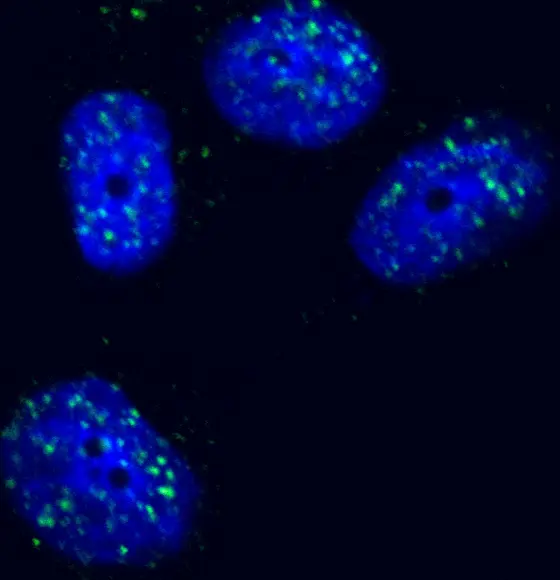Apoptosis plays an important role in fighting the development of cancer. For example, if a cell’s DNA undergoes irreparable damage as a result of UV radiation or chemotherapy, the affected cell sacrifices itself and commits suicide for the common good. However, to prevent healthy cells from killing themselves by mistake, complex signaling cascades are necessary before switching on a tumor suppressor called p53, the ultimate switch that leads to cell death. Previously researchers knew only that the HIPK2 enzyme must be active for the “death switch" to be activated. The process by which HIPK2 itself was activated, however, was unknown.
In the new study, the research team investigated the activity of the HIPK2 enzyme both in isolated cells and in zebrafish, an important model organism in cancer research. They compared the capability of normal HIPK2 enzymes to trigger apoptosis with that of a mutated form of the enzyme that is unable to incorporate phosphate, or can incorporate only small amounts of it. Both in the cells and in the model organisms, the mutated HIPK2 enzymes were unable to trigger apoptosis at the level attained by their normal peers.
In another step, the investigators carried out tests to unravel the role of the Pin1 enzyme – a protein that modifies the spatial folding and function of other proteins – in inducing apoptosis. Pin1 binds to HIPK2 molecules as soon as they have incorporated phosphate groups; however, it does not bind to the mutated variants that fail to incorporate phosphate groups. “The phosphorylation of HIPK2 activates the enzyme," Hofmann explains. “But for the activated HIPK2 enzyme to be stabilized, Pin1 has to bind to it and modify its folding pattern. When this happens, levels of HIPK2 rise in the cell and cell death can be induced."
Pin 1 has been known only for its role in cell division. It is commonly regarded as a key contributor to the uncontrolled growth of cancer cells. Initial trials are being carried out on Pin1 inhibitors, and therapies that combine these inhibitors with chemotherapy are being discussed for applications for the near future. However, the new results from the Heidelberg study are raising doubts about such combination therapies. “We believe that a combination of Pin1 and chemotherapy would be counterproductive. If Pin1 is inhibited, it can no longer stabilize HIPK2," says Thomas Hofmann. “This means that apoptosis would not be triggered and chemotherapy would not be effective.
To conduct the study, the researchers developed a new antibody that binds to the phosphate groups of HIPK2 enzymes. It permits scientists to observe when and where HIPK2 enzymes are active in a cell. The antibody will presumably also be useful in additional ways. “The newly developed phospho-HIPK2 antibody enables us to study where HIPK2 is active in the cell," Dr. Hoffmann says. “It can also be used as a molecular tool to predict the response of tumor cells to specific therapies." In a next step the researchers plan to use tumor material from patients to verify and expand upon the results of their research.
Publication:
Nadja Bitomsky, Elisa Conrad, Christian Moritz, Tilman Polonio-Vallon, Dirk Sombroek, Kathrin Schultheiss, Carolina Glas, Vera Greiner, Christoph Herbel, Fiamma Mantovani, Giannino del Sal, Francesca Peri and Thomas G. Hofmann: Autophosphorylation and Pin1 binding coordinate DNA damage-induced HIPK2 activation and cell death. Proceedings of the National Academy of Sciences, USA, 2013. Doi:10.1073/pnas.1310001110



